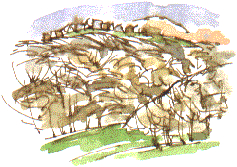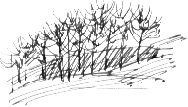Nature Diary Rocks History Gallery Links Home Page  TAKING THE PATH upstream for a change, within ten minutes I'm in amongst the moss-covered Crack Willows which tumble about on the marshy bed of what was once a mill dam in a steep, deep section of the little valley. The storm has smashed through a few more of the willows, adding to the wild aspect. It's immaterial to the Crack Willow if it is blown over. Beneath its bark there are latent buds which can sprout fresh shoots, so it may rise again. A fallen tree could give rise to several new trunks.
TAKING THE PATH upstream for a change, within ten minutes I'm in amongst the moss-covered Crack Willows which tumble about on the marshy bed of what was once a mill dam in a steep, deep section of the little valley. The storm has smashed through a few more of the willows, adding to the wild aspect. It's immaterial to the Crack Willow if it is blown over. Beneath its bark there are latent buds which can sprout fresh shoots, so it may rise again. A fallen tree could give rise to several new trunks.The stream is in spate, careering through the willows 20 yards beyond its normal course. The predominant sound here is of flowing water. Look around and the entire field of view is of woodland and wet.
For me this place has the same quality of wilderness as those remote parts of Scotland. It is probably because it is on a smaller scale and that it is so accessible that we tend to undervalue what we've got here. As barrister dismissed my a plea for part this valley last week by saying 'Mr Bell has come up with a list of common plant species.' Well, they say justice is blind.
A Green Woodpecker repeats its 'yaffling' call, a ringing maniacal laugh, which carries through the quiet woodland. When I reach the upper dam it seems strangely empty. A single Moorhen hurries from the wood back to the water as I appear. Then I'm startled as fifty Mallard suddenly get up from the sheep pasture with a rushing of wings and plummet down onto the dam in a froth of white water.
|

 Bracket Fungus grows on a Silver Birch trunk on the drier bank above the willow carr. It reminds me of a similar species that you see on birches in the Highlands.
Bracket Fungus grows on a Silver Birch trunk on the drier bank above the willow carr. It reminds me of a similar species that you see on birches in the Highlands. Cladonia lichen grows on stumps and the bare earth of steep banks. At first I think that the snake's head growths are some new species, then I realise that these will eventually become spore-bearing cups.
Cladonia lichen grows on stumps and the bare earth of steep banks. At first I think that the snake's head growths are some new species, then I realise that these will eventually become spore-bearing cups. As I climb the steep slope opposite, a view of the wood opens out behind me. You could be in a coomb in the depths of the Cotswolds. But climb higher and the sprawl of the local village peeps over the treetops from its embankment right on the skyline. The variously coloured houses resemble, from this distance, a series of crates that have fallen off the back of a lorry.
As I climb the steep slope opposite, a view of the wood opens out behind me. You could be in a coomb in the depths of the Cotswolds. But climb higher and the sprawl of the local village peeps over the treetops from its embankment right on the skyline. The variously coloured houses resemble, from this distance, a series of crates that have fallen off the back of a lorry. A smaller copse looms up ahead. The bare branches, silhouetted against the fading light of the winter sky, remind me of Paul Nash's (1889-1946) paintings of woods on the downs.
A smaller copse looms up ahead. The bare branches, silhouetted against the fading light of the winter sky, remind me of Paul Nash's (1889-1946) paintings of woods on the downs.